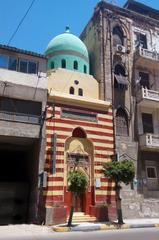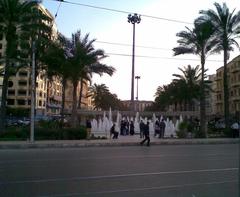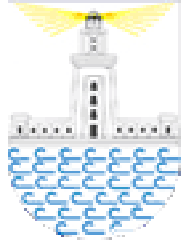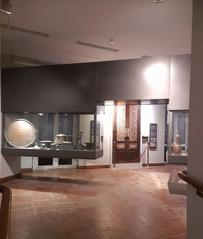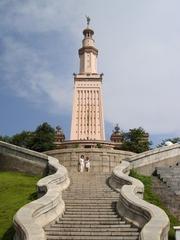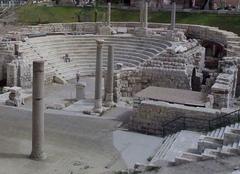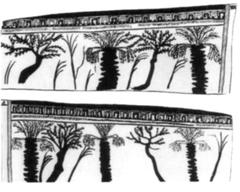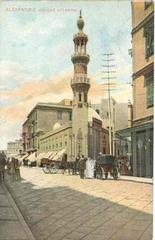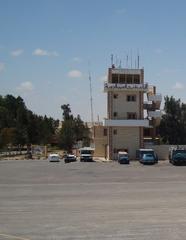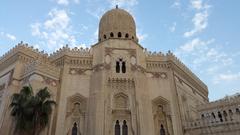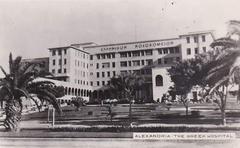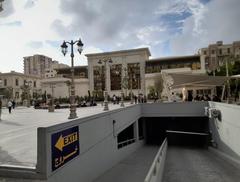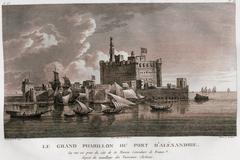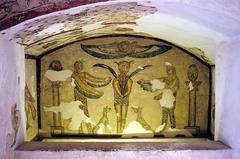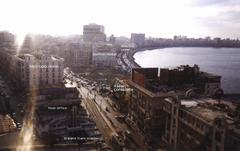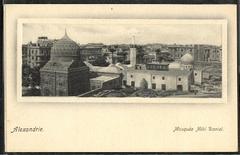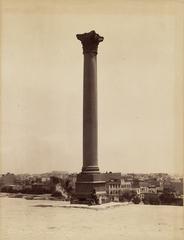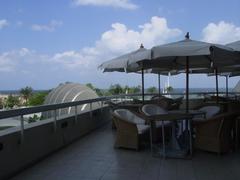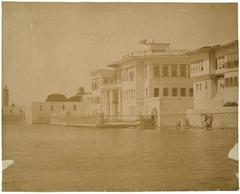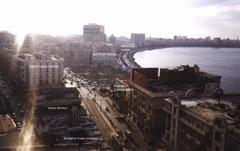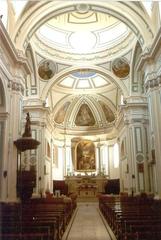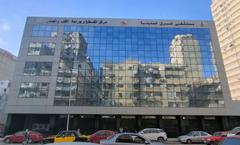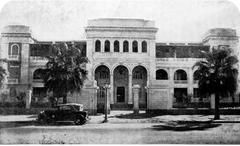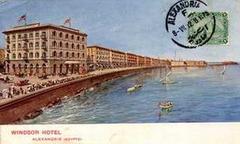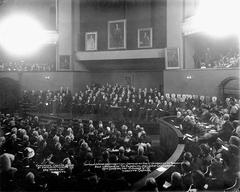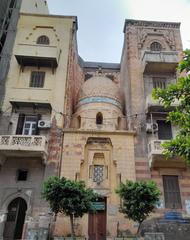Fouad Street Alexandria: Visiting Hours, Tickets, and Historical Sites Guide
Date: 14/06/2025
Introduction: The Living History of Fouad Street
Fouad Street, Alexandria, is not only a central artery of the city but also one of the oldest continuously inhabited planned streets in the world. Established as the Canopic Road by Alexander the Great in 331 BCE, this avenue has been the silent witness to Alexandria’s evolution from an ancient metropolis through Roman, Byzantine, Islamic, and Ottoman periods, and into the modern era. Today, Fouad Street is a vibrant tapestry of neoclassical, art deco, Italianate, and Mediterranean architecture, renowned cafés, and cultural landmarks such as the Alexandria Opera House and the Cavafy Museum. It remains a bustling hub for both locals and visitors—a place where the city’s multicultural heritage and cosmopolitan spirit are on full display. This guide provides essential information for travelers, including visiting hours, ticketing, accessibility, and tips to explore nearby attractions, ensuring a rich and informed experience of Fouad Street’s unique atmosphere. (Round City, Egypt Today, Egypt Independent)
Contents
- Introduction
- Historical Overview
- Ancient Foundations
- Roman, Byzantine, and Islamic Eras
- 19th–20th Century Cosmopolitanism
- Modern Transformations
- Visiting Fouad Street: Practical Information
- Visiting Hours
- Entrance and Tickets
- Accessibility
- Guided Tours
- Nearby Attractions
- Architectural and Cultural Highlights
- Notable Buildings and Landmarks
- Cafés, Patisseries, and Restaurants
- Cultural Centers and Museums
- Cultural Significance and Social Fabric
- Literary and Artistic Legacy
- Multiculturalism and Cosmopolitanism
- Religious and Community Landmarks
- Local Experiences and Activities
- Shopping and Street Life
- People-Watching and Daily Life
- Tram Rides and Urban Exploration
- Nightlife and Seasonal Events
- Practical Visitor Tips
- Best Time to Visit
- Getting There and Around
- Safety and Etiquette
- Recommended Itinerary
- Frequently Asked Questions (FAQ)
- Plan Your Visit
- Visual Guide
- Internal and External Links
- Summary
- Sources
Historical Overview
Ancient Foundations
Fouad Street’s origins trace back to the founding of Alexandria in 331 BCE, when Alexander the Great’s planners designed Canopic Road as the city’s main east-west axis. This street was the backbone of the Hippodamian grid plan and linked key sites, including the legendary Library of Alexandria and the royal quarter. Grand colonnades and Greek temples lined its route, testifying to its commercial and ceremonial importance. (Round City, Academia.edu)
Roman, Byzantine, and Islamic Eras
During the Roman and Byzantine periods, Fouad Street retained its central role as the city’s main thoroughfare, adapting to new urban and architectural trends. After the Arab conquest in the 7th century CE, Islamic influences reshaped the cityscape, yet the street’s alignment and importance endured. (Academia.edu)
19th–20th Century Cosmopolitanism
The 19th century ushered in a cosmopolitan golden age for Fouad Street, spurred by Muhammad Ali Pasha’s modernization efforts. The avenue flourished with neoclassical and Belle Époque architecture, and became home to Greeks, Italians, Jews, Armenians, and Levantines. Landmarks such as the Société Immobiliére building, Mohamed Ali Club, and the Alexandria Opera House reflect this era’s grandeur and multicultural vibrancy. Literary icons like Constantine Cavafy and E.M. Forster found inspiration here. (Egypt Independent, The Independent)
Modern Transformations
Following the 1952 Egyptian Revolution, Fouad Street underwent significant demographic and architectural changes. Some historic buildings fell into neglect, but others have been revived as cultural centers, galleries, and boutique hotels, sustaining the street’s eclectic character. Preservation initiatives and adaptive reuse continue to balance development with heritage protection. (Egyptian Streets, UNESCO)
Visiting Fouad Street: Practical Information
Visiting Hours
Fouad Street is a public avenue and accessible 24/7. For the fullest experience—shops, cafés, and cultural venues—plan your visit between 9:00 AM and 8:00 PM. Museums and attractions along the street may have specific hours:
- Alexandria Opera House: Tue–Sat, 10:00 AM–6:00 PM (events may vary)
- Roman Theatre and Kom el-Dikka: Daily, 9:00 AM–4:00 PM
- Cavafy Museum: Sat–Wed, 9:00 AM–5:00 PM
Entrance and Tickets
No ticket is required to walk along Fouad Street. Entry fees apply for specific attractions:
- Opera House: Tickets vary by performance
- Roman Theatre: ~60 EGP for adults
- Cavafy Museum: ~50 EGP
Tickets are available onsite or, for major events, via official websites or tourist offices.
Accessibility
Fouad Street is generally pedestrian-friendly with flat, wide sidewalks and tram access. However, some historic sites and cafés may have stairs or limited accessibility. Wheelchair users can navigate much of the street, but should check individual venues in advance.
Guided Tours
Local operators and cultural centers offer guided walking tours focusing on architecture, history, and culinary highlights. Tours often include stops at the Bibliotheca Alexandrina, the Corniche, and the Roman Amphitheatre. Booking in advance is recommended.
Nearby Attractions
- Bibliotheca Alexandrina: Modern library and cultural complex
- Alexandria National Museum: Artifacts from Pharaonic to modern eras
- Roman Amphitheatre (Kom el-Dikka): 4th-century ruins and mosaics
- Corniche: Waterfront promenade with Mediterranean views
Architectural and Cultural Highlights
Fouad Street’s built environment is a showcase of Alexandria’s layered history:
Notable Buildings and Landmarks
- Société Immobiliére Building (1928): Neo-Renaissance façade, now housing “L Passage,” a modern food court (The Independent)
- Mohamed Ali Club: Now the Alexandria Art Centre, a venue for exhibitions and performances
- Historic Cinemas: Including the Isis Cinema (opened 1910), a pioneer in the city’s film scene (Core.ac.uk)
- Alexandria Opera House (Sayed Darwish Theatre): Belle Époque landmark for music and performing arts
- Cecil Hotel: Famed for hosting royalty, politicians, and artists
Architectural styles on Fouad Street include neoclassical, art deco, art nouveau, and Ottoman influences, with ornate facades, curved balconies, and mashrabiya details. These features offer a visual journey through the city’s cosmopolitan heyday.
Cafés, Patisseries, and Restaurants
Fouad Street is synonymous with Alexandria’s café culture. Notable venues include:
- Trianon Patisserie: Renowned for French pastries and elegant ambiance—ideal for afternoon tea.
- Délices: Open since 1922, serves European and Egyptian desserts in an art deco setting.
- Pastroudis: Famous for pastries and coffee, a gathering spot for artists and intellectuals.
Options range from historic patisseries to modern restaurants:
- Chez Gaby Au Ritrovo: Italian cuisine with wood-fired pizzas
- Santa Lucia: Mediterranean fare with fresh seafood
- Street Food: Vendors offer Egyptian classics like koshari and taameya
Cultural Centers and Museums
- Cavafy Museum: Dedicated to the Greek poet Constantine Cavafy.
- Alexandria Art Centre: Hosts exhibitions and performances.
Cultural Significance and Social Fabric
Literary and Artistic Legacy
Fouad Street has inspired literary giants like Constantine Cavafy, Lawrence Durrell, and E.M. Forster. The area’s literary and artistic vibrancy continues today, with cultural centers, galleries, and bookshops dotting the street (Ek Alexandria).
Multiculturalism and Cosmopolitanism
Historically home to Greeks, Italians, Armenians, Jews, Levantines, and Egyptians, the street’s diverse communities are reflected in its architecture and cuisine. Cafes like Délices and Trianon, founded by European families, remain popular (Egypt Today).
Religious and Community Landmarks
Religious sites nearby include St. Mark’s Coptic Orthodox Cathedral and the Eliyahu Hanavi Synagogue, showcasing Alexandria’s pluralistic heritage.
Local Experiences and Activities
Shopping and Street Life
Fouad Street is a shopping haven, lined with boutiques, antique shops, and modern stores. Visitors can browse for traditional crafts, vintage items, designer wear, and electronics. Haggling is common and part of the local experience (Memphis Tours).
People-Watching and Daily Life
The street is ideal for people-watching, especially on Friday mornings when locals stroll, shop, and socialize. Street vendors sell everything from snacks to souvenirs, and the mix of residents, students, and tourists creates a lively atmosphere (Local Guide to Egypt).
Tram Rides and Urban Exploration
Alexandria’s tram system, in operation since 1860, is one of the oldest in the world. Riding the tram along or near Fouad Street offers a nostalgic and affordable way to see the city. Women-only cars are available for solo female travelers (Local Guide to Egypt).
Nightlife and Seasonal Events
In the evenings, Fouad Street comes alive with bars, music lounges, and shisha cafés. Rooftop venues offer city and sea views, while live music ranges from traditional oud to jazz. During Ramadan and Eid, the street glows with festive lights and special markets, while spring and autumn bring art fairs and festivals celebrating Alexandria’s artistic spirit.
Practical Visitor Tips
Best Time to Visit
- Climate: Alexandria enjoys a Mediterranean climate. The best months to visit are from October to April, when temperatures are mild (15–25°C/59–77°F) and humidity is lower.
- Events: Check for cultural festivals, art exhibitions, and performances at the Opera House or Teatro Eskendria.
Getting There and Around
- Location: Fouad Street runs through central Alexandria, easily accessible by taxi, tram, or on foot from major hotels and attractions.
- Transport: Taxis are plentiful and affordable. The tram is a unique local experience, though not the fastest option.
- Walking: The street is pedestrian-friendly, but be mindful of traffic and uneven pavements.
Safety and Etiquette
- Safety: Alexandria is generally safe for tourists, but standard precautions apply. Keep valuables secure and be aware of your surroundings.
- Dress Code: While Alexandria is more liberal than other Egyptian cities, modest dress is recommended, especially when visiting religious sites or traditional cafés.
- Photography: Some historic buildings and museums may charge extra for photography. Always ask permission before photographing people.
Recommended Itinerary
Morning:
- Start with breakfast at Trianon or Délices.
- Visit the Alexandria Opera House and nearby historic buildings.
Midday:
- Explore boutiques and antique shops.
- Lunch at Chez Gaby or Teatro Eskendria.
Afternoon:
- Visit the Cavafy Museum and Alexandria Art Centre.
- Stroll towards the statue of Alexander the Great and the Bibliotheca Alexandrina.
Evening:
- Enjoy tea at Pastroudis or a seafood dinner at a nearby restaurant.
- Attend a performance or exhibition if available.
Frequently Asked Questions (FAQ)
Q: Are there any entrance fees to visit Fouad Street?
A: No, Fouad Street is a public street with free access. Entry fees apply only for certain museums and venues.
Q: What are the best times to visit Fouad Street?
A: Late morning to late evening for shops and cafés; December to February for pleasant weather.
Q: Are guided tours available?
A: Yes, local operators offer guided walking tours; bookings can be made online or at cultural centers.
Q: Is Fouad Street accessible for people with disabilities?
A: Many parts are accessible, but some older buildings may have limited access.
Q: Where can I find official information or tickets for nearby museums?
A: Check official museum websites or trusted travel platforms for up-to-date info.
Plan Your Visit
Fouad Street is Alexandria’s vibrant heart, offering something for every traveler: historic architecture, café culture, shopping, art, and nightlife. For the best experience:
- Visit during the recommended hours for full access to shops and venues
- Consider a guided tour for deeper insights
- Download the Audiala app for interactive maps, audio guides, and up-to-date event info
- Respect local customs and property
- Check official attraction websites for the latest hours and ticket prices
Visual Guide
- Panoramic view of Fouad Street with Mediterranean backdrop (alt: “Panoramic view of Fouad Street, Alexandria”)
- Interior of Pastroudis café with vintage décor (alt: “Pastroudis café interior with vintage décor”)
- Street food vendors selling koshari and taameya (alt: “Street food vendors selling Egyptian koshari and taameya on Fouad Street”)
- Nighttime rooftop bar scene with city lights (alt: “Rooftop bar on Fouad Street with city and sea views at night”)
Internal and External Links
Summary
Fouad Street is a testament to Alexandria’s enduring spirit—a street where ancient history, cosmopolitan culture, and modern Egyptian life converge. For travelers, it offers more than just sightseeing; it is an immersive journey through time, architecture, and community. The street’s unique blend of heritage and vitality, coupled with its accessible location and diverse attractions, makes it an essential destination for anyone seeking to understand Alexandria’s past and present. For up-to-date visitor information, guided tours, and cultural events, consult official resources and download the Audiala app to enhance your experience (Ahram Online, UNESCO, Wanderlog).
Sources
- Round City: Fouad Street, the Oldest Planned Still Inhabited Street in the World
- Egypt Today: Exploring Fouad Street in Alexandria
- Wanderlog: Fouad Street Alexandria Visitor Experience
- Egypt Independent: Alexandria’s Fouad Street—A Longing for Its Elegant Past
- Ahram Online: Fouad Street, Alexandria’s Historic Heart
- Academia.edu: Migration and Architectural Transformation In Alexandria, Egypt
- Egyptian Streets: From Pharaohs to Pashas—Revisiting Alexandria’s Fouad Street
- Egypt Independent: Fouad Street, Alexandria’s Living History
- UNESCO Tentative List: Alexandria Historical Sites
- The Independent: Alexandria Building Photo Essay, Fouad Street’s History

